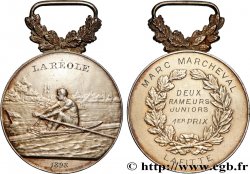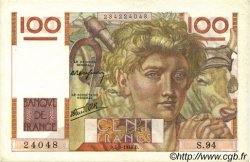fme_756461 - TERZA REPUBBLICA FRANCESE Médaille, Administration des monnaies
non disponibile.
Articolo venduto sul nostro negozio (2024)
Prezzo : 12.00 €
Articolo venduto sul nostro negozio (2024)
Prezzo : 12.00 €
Tipo : Médaille, Administration des monnaies
Data: 1878
Metallo : bronzo
Diametro : 30 mm
Asse di coniazione : 12 h.
Incisore Barre
Peso : 14,92 g.
Orlo : lisse
Marchio : sans poinçon
Commenti sullo stato di conservazione:
Patine hétérogène, du rouge de frappe encore visible
Diritto
Titolatura diritto : REPUBLIQUE FRANCAISE ; SUFFRAGE UNIVERSEL SUR LE BANDEAU.
Descrittivo diritto : Buste de la République à gauche avec un bandeau sur la tête. Signé : BARRE.
Rovescio
Titolatura rovescio : ADMINIST. / DES / MONNAIES / - / EXPOSITION / UNIVERSELLE / PARIS / 1878.
Descrittivo rovescio : en sept lignes dans une couronne de laurier, chêne et blé.
Commento
Il s'agit de la médaille frappée devant les visiteurs, au stand de la Monnaie, à l'Exposition Universelle de 1878
Les expositions universelles ont été créées pour présenter les réalisations industrielles des différentes nations. Elles représentaient la vitrine technologique et industrielle des participants, témoignant du progrès au cours de la révolution industrielle. La première exposition universelle s'est déroulée à Londres en 1851.
À l'origine, chaque pays disposait d'un espace réservé dans un pavillon central. À partir de 1867, des pavillons nationaux firent leur apparition. En principe, ils étaient attribués seulement s'il y avait des choses à présenter que le pavillon central ne pouvait accueillir. Ils ne tardèrent pas à se généraliser, les nations exposantes construisant des pavillons typiques de l'architecture de leurs pays.
La compétition était omniprésente dans les expositions universelles, et des concours permettaient aux plus méritants d'obtenir des médailles bénéficiant d'un certain prestige.
De nombreuses réalisations architecturales construites à l'occasion d'expositions universelles sont devenues par la suite des symboles des villes qui les ont abritées : la tour Eiffel à Paris, l'Atomium à Bruxelles, le Space Needle à Seattle, la Biosphère à Montréal.
Enfin, la tenue des expositions universelles a toujours été l'occasion de mettre en place des projets d'urbanisme : construction du métro de Paris en 1900 ou celui de Montréal en 1967, extension du métro de Lisbonne en 1998…
Voir http://fr.wikipedia.org/wiki/Exposition_universelle .
This is the medal struck in front of visitors, at the Mint stand, at the 1878 Universal Exhibition. Universal exhibitions were created to showcase the industrial achievements of different nations.. They represented the technological and industrial showcase of the participants, testifying to progress during the industrial revolution.. The first World's Fair took place in London in 1851..
Originally, each country had a dedicated space in a central pavilion. From 1867, national pavilions appeared. In principle, they were only allocated if there were things to be presented that the central pavilion could not accommodate.. They soon became widespread, with exhibiting nations building pavilions typical of the architecture of their countries..
Competition was omnipresent at world fairs, and competitions allowed the most deserving to obtain medals that carried a certain prestige..
Many architectural achievements built for world exhibitions have subsequently become symbols of the cities that hosted them: the Eiffel Tower in Paris, the Atomium in Brussels, the Space Needle in Seattle, the Biosphere in Montreal..
Finally, the holding of universal exhibitions has always been an opportunity to implement urban planning projects: construction of the Paris metro in 1900 or that of Montreal in 1967, extension of the Lisbon metro in 1998… See http://fr. Wikipedia. org/wiki/Exposition_universelle
Les expositions universelles ont été créées pour présenter les réalisations industrielles des différentes nations. Elles représentaient la vitrine technologique et industrielle des participants, témoignant du progrès au cours de la révolution industrielle. La première exposition universelle s'est déroulée à Londres en 1851.
À l'origine, chaque pays disposait d'un espace réservé dans un pavillon central. À partir de 1867, des pavillons nationaux firent leur apparition. En principe, ils étaient attribués seulement s'il y avait des choses à présenter que le pavillon central ne pouvait accueillir. Ils ne tardèrent pas à se généraliser, les nations exposantes construisant des pavillons typiques de l'architecture de leurs pays.
La compétition était omniprésente dans les expositions universelles, et des concours permettaient aux plus méritants d'obtenir des médailles bénéficiant d'un certain prestige.
De nombreuses réalisations architecturales construites à l'occasion d'expositions universelles sont devenues par la suite des symboles des villes qui les ont abritées : la tour Eiffel à Paris, l'Atomium à Bruxelles, le Space Needle à Seattle, la Biosphère à Montréal.
Enfin, la tenue des expositions universelles a toujours été l'occasion de mettre en place des projets d'urbanisme : construction du métro de Paris en 1900 ou celui de Montréal en 1967, extension du métro de Lisbonne en 1998…
Voir http://fr.wikipedia.org/wiki/Exposition_universelle .
This is the medal struck in front of visitors, at the Mint stand, at the 1878 Universal Exhibition. Universal exhibitions were created to showcase the industrial achievements of different nations.. They represented the technological and industrial showcase of the participants, testifying to progress during the industrial revolution.. The first World's Fair took place in London in 1851..
Originally, each country had a dedicated space in a central pavilion. From 1867, national pavilions appeared. In principle, they were only allocated if there were things to be presented that the central pavilion could not accommodate.. They soon became widespread, with exhibiting nations building pavilions typical of the architecture of their countries..
Competition was omnipresent at world fairs, and competitions allowed the most deserving to obtain medals that carried a certain prestige..
Many architectural achievements built for world exhibitions have subsequently become symbols of the cities that hosted them: the Eiffel Tower in Paris, the Atomium in Brussels, the Space Needle in Seattle, the Biosphere in Montreal..
Finally, the holding of universal exhibitions has always been an opportunity to implement urban planning projects: construction of the Paris metro in 1900 or that of Montreal in 1967, extension of the Lisbon metro in 1998… See http://fr. Wikipedia. org/wiki/Exposition_universelle








 Segnalare un errore
Segnalare un errore Stampate la pagina
Stampate la pagina Condividi mia selezione
Condividi mia selezione Fai una domanda
Fai una domanda Consegnare / vendere
Consegnare / vendere
 Descrittivo
Descrittivo















